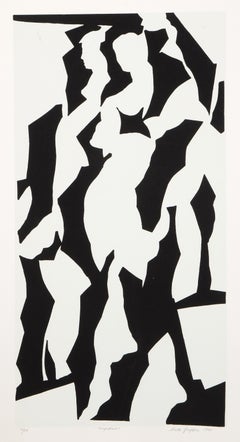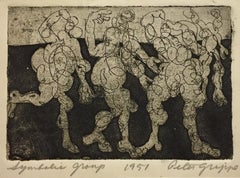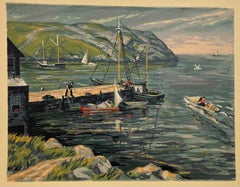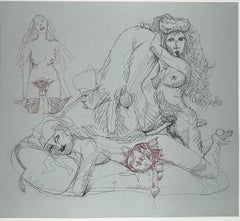Peter Grippe Prints and Multiples
to
1
1
2
Overall Width
to
Overall Height
to
2
2
5
1,183
937
886
817
4
3
1
3
1
2
1
1
1
1
3
1
4
Artist: Peter Grippe
Negative, Modern Screenprint by Peter Grippe
By Peter Grippe
Located in Long Island City, NY
Peter Grippe, American (1912 - 2002) - Negative, Year: 1960, Medium: Screenprint, signed, titled, numbered and dated in pencil, Edition: 50, Image Size: 39 x 20 inches, Size: 46 x ...
Category
1960s Modern Peter Grippe Prints and Multiples
Materials
Screen
Peter Grippe, Symbolic Group
By Peter Grippe
Located in New York, NY
This work is signed, titled, and dated, in pencil. Grippe was a master printer, highly creative printmaker, and sculptor.
Category
1950s American Modern Peter Grippe Prints and Multiples
Materials
Intaglio
Positive, Signed Abstract Screenprint by Peter Grippe
By Peter Grippe
Located in Long Island City, NY
Artist: Peter Grippe, American (1912 - 2002)
Title: Positive
Year: 1960
Medium: Silkscreen, signed and numbered in pencil
Edition: 50
Image Size: 39 x 20 inches
Size: 46 x 35 in. (11...
Category
1950s Pop Art Peter Grippe Prints and Multiples
Materials
Screen
Positive 2, Abstract Screenprint by Peter Grippe
By Peter Grippe
Located in Long Island City, NY
Artist: Peter Grippe, American (1912 - 2002)
Title: Positive 2
Year: 1958-1960
Medium: Screenprint, signed and numbered in pencil
Edition: 75
Image Size: 26 x 20.25 inches
Size: 34 x...
Category
1950s Pop Art Peter Grippe Prints and Multiples
Materials
Screen
Related Items
Harry Shokler, Island Harbor
By Harry Shokler
Located in New York, NY
Harry Shokler used serigraphy to great advantage in this landscape. It's colorful and detailed.
It is signed in the image at the lower left. When printmakers began making serigraphs...
Category
1940s American Modern Peter Grippe Prints and Multiples
Materials
Screen
Four Figures and a Head, on Giant Phallus by Claes Oldenburg erotic nude scene
By Claes Oldenburg
Located in New York, NY
This sensuous and playful scene is characteristic of Oldenburg’s printmaking ouevre: a veritable heap of women displaying various expressions of joy and come-hither coquettishness. T...
Category
1970s Modern Peter Grippe Prints and Multiples
Materials
Etching
Madman's Drum (Brothel) — 'Story Without Words' Graphic Modernism
By Lynd Ward
Located in Myrtle Beach, SC
Lynd Ward, 'Madman's Drum, Plate 41', wood engraving, 1930, edition small. Signed in pencil. A fine, richly-inked impression, on off-white tissue-thin Japan paper; the full sheet with margins (1 5/8 to 2 1/2 inches); a small paper blemish in the upper right margin, away from the image, otherwise in excellent condition. A scarce, artist-printed, hand-signed proof impression before the published edition. Matted to museum standards, unframed.
Image size 5 1/2 x 3 3/4 inches (140 x 95 mm); sheet size 9 5/8 x 7 1/8 inches (244 x 181 mm).
From Lynd Ward’s book of illustrations without words, 'Madman’s Drum', Jonathan Cape and Harrison Smith, New York, 1930.
Reproduced in 'Storyteller Without Words, the Wood Engravings of Lynd Ward', Harry N. Abrams, New York, 1974.
ABOUT THE ARTIST
Lynd Ward is acknowledged as one of America’s foremost wood engravers and book illustrators of the first half of the twentieth century. His innovative use of narrative printmaking as a stand-alone storytelling vehicle was uniquely successful in reaching a broad audience. The powerful psychological intensity of his work, celebrated for its dynamic design, technical precision, and compelling dramatic content, finds resonance in the literature of Poe, Melville, and Hawthorne. Like these classic American writers, Ward was concerned with the themes of man’s inner struggles and the role of the subconscious in determining his destiny. An artist of social conscience during the Great Depression and World War II, he infused his graphic images with his unique brand of social realism, deftly portraying the problems that challenged the ideals of American society.
The son of a Methodist preacher, Lynd Ward, moved from Chicago to Massachusetts at an early age. He graduated from the Teachers College of Columbia University, New York, in 1926, where he studied illustration and graphic arts. He married May Yonge McNeer in 1936 and left for Europe for their honeymoon in Eastern Europe. After four months, they settled in Leipzig, where Ward studied at the National Academy of Graphic Arts and Bookmaking. Inspired by Belgian expressionist artist Frans Masereel's graphic novel ‘The Sun,’ and another graphic novel by the German artist Otto Nückel, ‘Destiny,’ he determined to create his own "wordless" novel. Upon his return to America, Ward completed his first book, ‘God's Man: A Novel in Woodcuts,’ published in 1929. ‘Gods’ Man’ was a great success for its author and publisher and was reprinted four times in 1930, including a British edition. This book and several which followed it, ‘Madman’s Drum,’ 1930, ‘Wild Pilgrimage...
Category
1930s American Modern Peter Grippe Prints and Multiples
Materials
Woodcut
$650
H 5.07 in W 3 in D 0.01 in
Sister Corita Kent, Yes to You silkscreen, Hand Signed Artists Proof with heart
By Corita Kent
Located in New York, NY
Corita Kent
Yes to You, 1979
Color silkscreen
Hand signed, numbered and uniquely inscribed with a heart doodle by the artist on the front.
Artists Proof (aside from the regular editi...
Category
1970s Pop Art Peter Grippe Prints and Multiples
Materials
Screen
$2,800
H 11.75 in W 11.75 in D 1.5 in
'Eyes for the Night' — Mid-century American Surrealism
By Benton Murdoch Spruance
Located in Myrtle Beach, SC
Benton Spruance, 'Eyes for the Night', lithograph, 1947, edition 35, Fine and Looney 260. Signed, dated, titled, and annotated 'Ed 35' in pencil. A fine impression, on heavy, cream ...
Category
1940s American Modern Peter Grippe Prints and Multiples
Materials
Lithograph
$720 Sale Price
20% Off
H 18.88 in W 12.88 in
Original Mardi Gras New Orleans 1978 festival serigraph poster
Located in Spokane, WA
Original Mardi Gras, New Orleans, 1978 linen-backed poster. Dressed up in what would be an American Indian costume with full headgear, he is holding a shield with a horse on it. Indian decoration on the footwear. Signed and numbered.
I believe this has to deal with Big Chief leading his Congo Nation Mardi Gras Indian group. Zulu Parade. Many of the original Mardi Gras jazz posters...
Category
1970s American Modern Peter Grippe Prints and Multiples
Materials
Screen
$636 Sale Price
20% Off
H 32 in W 23 in D 0.05 in
1 (One), from the original Numbers portfolio (Sheehan 46-55)
By Robert Indiana
Located in New York, NY
Robert Indiana
1, from the original Numbers portfolio (Sheehan 46-55), 1968
Color Silkscreen on Wove Paper
Limited Edition of 2500
Not Signed
Frame included: Elegantly matted and fra...
Category
1960s Pop Art Peter Grippe Prints and Multiples
Materials
Screen
$1,000
H 12.75 in W 10.25 in D 1.25 in
Mother And Child
By Romare Bearden
Located in New York, NY
Color screenprint on paper. Signed by the artist in pencil, lower right. Numbered 71/200 in pencil, lower left.
Catalogue raisonne refernece: Gelburd/Rosenberg 59.
Framed d...
Category
1970s Modern Peter Grippe Prints and Multiples
Materials
Screen, Color
Prêtresse antique (Ancient Priestess)
By Félicien Rops
Located in Middletown, NY
Heliogravure by Félicien Rops (1833 – 1898), a Belgian artist, known primarily as a printmaker in etching and aquatint. He is noted for his drawings depicting erotic and Satanic them...
Category
Late 19th Century Symbolist Peter Grippe Prints and Multiples
Materials
Handmade Paper, Photogravure, Stencil
Original CAZALIS & PRATS Grand Cru Mermaid vintage French liquor poster
Located in Spokane, WA
Original CAZALIS & PRATS since 1875. Artist: Emm. Gaillard. Size: 13" x 19.5". Professionally acid-free archival linen backed and ready to frame. Note that a small ink printing line ...
Category
1950s American Modern Peter Grippe Prints and Multiples
Materials
Lithograph
$595
H 19.5 in W 13 in D 0.05 in
Original Continental Airlines limited edition Serigraph vintage travel poster
Located in Spokane, WA
Original Continental Airlines travel poster. Linen backed in fine condition. Signed and numbered 35/50.
This original Continental Airlines poster is an artistic representation of regional destinations prominently served by Continental Airlines in the past. The design is modern and bold, showcasing a unique black-and-white theme with strong, futuristic typography and graphical illustrations. Each city is creatively depicted using stylized imagery that resonates with its character—Oklahoma City features a cowboy motif, New Orleans embraces a jazzy, cultural essence, Dallas reflects the energy of movement, and Midland/Odessa highlights industrial and oil-centric themes.
This limited-edition poster is printed in black and white. It features the destinations of Hawaii, San Francisco, Albuquerque and Portland Above each name is a design that represents each destination city.
Hawaii has rows of palm trees and hula dancers. San Francisco has rolling hills and cable cars. Albuquerque has tribal Indians dancing. Portland has the cruise shipping. This image features the Saul Bass l967 Continental logo in the design.
Continental Airlines was a major United States airline founded in 1934 and eventually headquartered in Houston, Texas.
The airline was acquired by UAL Corporation, the parent company of United Airlines, on October 1, 2010.
This is an original vintage Continental Airlines poster...
Category
Late 20th Century American Modern Peter Grippe Prints and Multiples
Materials
Screen
$675
H 40 in W 26.5 in D 0.3 in
Original Talco Paglieri - al Boro Timo, Italian vintage mid-century modern poste
By Gino Boccasile
Located in Spokane, WA
Original Talco Paglieriri Italian poster, Linen backed by Gino Boccasile. Size: 13.25" x 19". Year: c. 1949-1950. Very good condition. Grade A., ready to frame.
The bab...
Category
1940s American Modern Peter Grippe Prints and Multiples
Materials
Offset
Gino BoccasileOriginal Talco Paglieri - al Boro Timo, Italian vintage mid-century modern poste, 1949
$325
H 18.5 in W 13.5 in D 0.05 in
Peter Grippe prints and multiples for sale on 1stDibs.
Find a wide variety of authentic Peter Grippe prints and multiples available for sale on 1stDibs. You can also browse by medium to find art by Peter Grippe in screen print, intaglio and more. Much of the original work by this artist or collective was created during the 1950s and is mostly associated with the Pop Art style. Not every interior allows for large Peter Grippe prints and multiples, so small editions measuring 6 inches across are available. Customers who are interested in this artist might also find the work of Giovanni Pintori, Caroline Durieux, and Arthur William Heintzelman.. Peter Grippe prints and multiples prices can differ depending upon medium, time period and other attributes. On 1stDibs, the price for these items starts at $600 and tops out at $1,500, while the average work can sell for $650.



